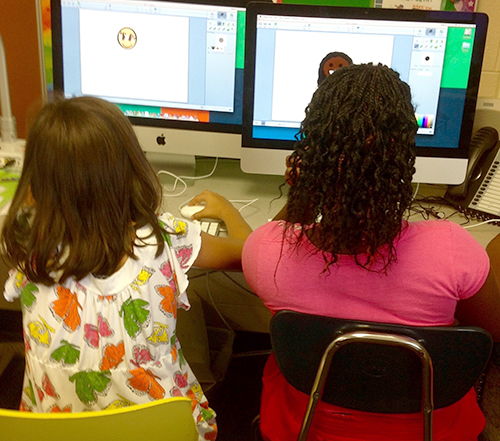Chapter 4: Responsibilities to Consider as Digital Citizens
4.1 Jumping In

As I mentioned at the beginning of this chapter, I am a literacy coach. At one of my professional meetings, I had the pleasure of learning from Deb Frazier and Cathy Mere. They shared the things that they were doing digitally with their first grade students and I found my mind starting the spin. The videos and student work that they shared gave me the inspiration that I needed to get started! The level of writing was not that different from a typical first grader, but the difference in the level of thinking was huge. They were making purposeful decisions about their writing, that I hadn’t considered as an adult. For example, one child articulated his writing process and his thinking behind choosing a particular digital tool to publish his work. In addition, first graders are able to share so much when oral storytelling, but often don’t have the stamina or skills to sustain writing longer pieces. Many digital tools allow students to use a combination of images, text and voice to express meaning. I knew I wanted these opportunities for the students in my building.
I returned to school the next day and immediately sent an email to the staff that I worked with asking them if I would be able to work with them and their students on blogging. I decided to begin with blogging because blogging was a linear process. Three teachers answered my plea. I began my work with a 3rd grader teacher who had been thinking about blogging with her students, and two first grade teachers. They were excited that I was willing and eager to jump into this with them. During this chapter, I will focus on the work that I did with the third grade teacher.
This was our first time to introduce blogging to the children, so we had to really think about what they needed to know and how they needed to know it. There are lists out there for teachers to read, but as I know from experience, all kids are different. We wanted to make the teaching specific to the students.
When Megan (the third grade teacher) and I met, we had to consider the background knowledge of the students. We wondered if they had even seen a blog before and we discovered that most of them had not. So that’s where we began. I created a slide show using google slides to help us with our organization when teaching. On one of the slides, I included a link to different blogs written by children. I chose blogs that I thought that the children would be able to use as a mentor text.
“Blogging in the 3rd Grade” Presentation
Mrs. Steahly’s Bloggers shows the VoiceThread I made to help students create their first blogs.
After showing the blogs to the children, reading a few posts and talking about what the writers did on their blogs, Megan and I began by teaching the kids the basics like how to get on the blog , how to post, how to comment, how to post a picture or a video, etc. We didn’t teach all of this all at once. We would teach one thing, then get the children on the computers to try it out. Then we would teach another skill and give them time to try it out.
This got the children started, but I was naive to think that this was all that they needed. My approach to blogging, which was thinking that children were writing as in writing workshop, but on a blog, made me miss the essential responsibilities that digital writers have to their audiences and to each other. As in writing workshop, they needed to make sure that they were still writing for an audience. They also needed to learn the importance of protecting their privacy and the privacy and feelings of others. Responsibilities as digital readers and writers are vast and growing as the amount of reading and writing digitally and their accessibility grows.